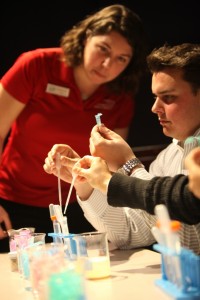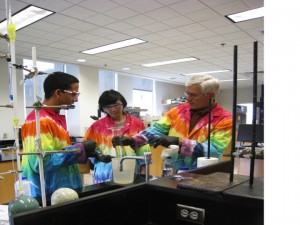SENCER-ISE (Science Education for New Civic Engagements and Responsibilities-Informal Science Education) is a National Center for Science and Civic Engagement initiative to support partnerships between informal science and higher education institutions. SENCER-ISE currently includes ten cross-sector partnerships offering a range of civic engagement activities for K-12, undergraduate and graduate students, and the public.
View our online brochure for SENCER-ISE “at a glance.”
What’s Happening in SENCER-ISE

NYC high school students learn about urban ecology from a Fordham University student. Photo credit: Bud Glick
The Fordham University and Wildlife Conservation Society partnership’s post on the CAISE Perspectives blog is the third installment of SENCER-ISE’s contribution to the museum-university series.
Jennifer D. Adams, associate professor of Science Education and Earth and Environmental Sciences at Brooklyn College and one of the co-investigators for the SENCER-ISE supported project, Sentinels of Shoreline Change was recently featured in
Brooklyn College Magazine’s issue on “Women Who Shape the World,” a broad-ranging article on social and academic challenges faced by girls and women. Adams recently placed her involvement with the Lang Program in the context of the role of informal education and its links to the more formal classroom. With informal science education’s emphasis on place-based, project-based, and collaborative learning, the connection enriches the educational experience and provides more opportunities for students to learn about real life applications of science that can engage them and also help them find a niche for themselves in STEM fields. Teacher education and teacher professional development initiatives can incorporate elements of informal science education into their programs. Continue reading for Adams’s remarks about place-based, project-based, and collaborative teaching.

Research is highlighted at a Sciencenter Family Workshop where Cornell University students and ECC Lab researchers work with young participants. Photo credit Sciencenter
The Cornell University and Sciencenter partnership has been featured on the CAISE Perspectives blog as part of SENCER-ISE’s mini Spotlight series on museum-university partnership

Dr. Steve Bachofer, SENCER-ISE Co-PI at Saint Mary’s College of California talks with work session participants. Photo by Hailey Chenevert
SENCER-ISE has been featured on the the Center for Advancement of Informal Science Education (CAISE) Perspectives blog spotlight series on museum-university partnerships.
NCSCE is pleased to welcome Marsha Semmel and David Ucko as senior advisors to the SENCER-ISE project.

CAISE Director, Jamie Bell, addresses 2014 NSF AISL PI meeting attendees. Photo by Hailey Chenevert.

Dr. Linda Fuselier, SENCER-ISE Co-PI at Antioch College, presents to SSI work session participants. Photo by Hailey Chenevert.
SENCER-ISE Representatives attend the 2014 National Science Foundation AISL (Advancing Informal STEM Learning) Principal Investigator meeting, hosted by CAISE (Center for Advancement of Informal Science Education).
SENCER-ISE Partners attend the 2014 SENCER Summer Institute, hosted by the University of North Carolina Asheville.
“It was an inspiring, thought-provoking and action-filled few days.” Michelle Kortenaar
Hamilton College and the Green Science Policy Institute Welcome Hope and Oberlin Collages to their SENCER-ISE Civic Engagement Partnership!

Graduate student from the Early Childhood Cognition Lab, Nadia Chernyak, conducts a study with child participant. Photo by Sciencenter
Dr. Tamar Kushnir and Michelle Kortenaar are awarded a 2014 Innovative Pilot Study seed grant from Cornell University’s Bronfenbrenner Center for Transitional Research (BCTR) to expand the research component of their SENCER-ISE project.

Stephanie Airoldi of the Connecticut Science Center works with adult visitors. Photo by the Connecticut Science Center.
University of Connecticut and the Connecticut Science Center prepare for summer Genome Ambassador public programs.
“We like the tie between the summer genomics program for high school students and the SENCER-ISE graduate student project as it broadens the experience for all involved.”
Saint Mary’s College and Lindsay Wildlife Museum mobile app now available for download.
Karen Tingley, SENCER-ISE Co-Director at the Wildlife Conservation Society, partnering with Fordham University on Project TRUE, was project director for the two-year project “Building Strong Community Networks.”
“Karen’s work on the BSCN demonstrate the value of collaborative educational and cultural partnerships in addressing community or civic needs.” – Dr. Ellen Mappen

Saint Mary’s College Students present their app design ideas to Lindsay Wildlife Museum Staff. Photo by Steve Bachofer
Saint Mary’s College and the Lindsay Wildlife Museum’s Wildlife Mobile App will be available for download soon. The app was designed and developed by Saint Mary’s School of Science students with the guidance of the Lindsay Wildlife Museum.
Students at Paul Smith’s College, with the guidance of The Wild Center, present communicate the impact of climate change in Adirondack Park to community gatekeepers.
“The point is… to empower people to make their own informed decisions about how to deal with changes that are already under way in the North Country.” – Prof. Curt Stager

RVCC students present a workshop on identifying invasive plant species to citizen scientists. Photo by Jay Kelly.
Raritan Valley Community College (RVCC) and the New Jersey Audubon revamp an RVCC Environmental Studies course and integrate student trainers into NJ Audubon citizen scientists workshops.
“Receiving hands on experience with the information that I learned has definitely deepened my understanding of the issues of invasive species”–RVCC Student
 On April 24, 2014, the Koshland Science Museum celebrated its 10-year anniversary with the opening of the Idea Lab, an unconventional gallery space where the museum plans to pilot interactive approaches in collaboration with visitors. The Idea Lab, with the inaugural theme of “community resilience,” features interactive games, access to real-time data about weather and other public emergency alerts, and much more.
On April 24, 2014, the Koshland Science Museum celebrated its 10-year anniversary with the opening of the Idea Lab, an unconventional gallery space where the museum plans to pilot interactive approaches in collaboration with visitors. The Idea Lab, with the inaugural theme of “community resilience,” features interactive games, access to real-time data about weather and other public emergency alerts, and much more.
Visit the Koshland Science Museum’s website to learn more about the Idea Lab and the museum’s other exhibits.

Dr. John Falk joins twenty NM ISE Net members for a luncheon prior to his presentation. Photo by Charlie Walter.
Dr. John Falk, Sea Grant Professor of Free-Choice Learning at Oregon State University and Director of the OSU Center for Research on Lifelong STEM Learning, spoke to seventy-five members of the New Mexico Informal Science Education Network. Dr. Falk presented on what is currently known about when, why, and where the public learns science.

Basic chemistry, such as chemical partitioning, is introduced early in the term to help students design strategies for separating toxins from various materials before quantification is possible. Photo: Karen Brewer
Hamilton College and the Green Science Policy Institute work together from across the United States to transform an Introduction to Chemistry course into a toxicology lab, which includes civic engagement elements to provide students with opportunities to share their findings with the public.
“The questions are beginning to extend beyond the simple act of measuring toxins to a broader consideration of the next important questions…”- Prof. Tim Elgren

Graduate student from the Early Childhood Cognition Lab, Nadia Chernyak, conducts a study with child participant. Photo by Sciencenter.
Mariel Schneider, a senior at Cornell University, has been involved in the implementation of Cornell University and the Sciencenter’s SENCER-ISE project, Science from the Start: Engaging Researchers, Undergraduates and a Science Museum to Research Early Learners and Set the Stage for STEM Learning, for over six months. Mariel recently reflected on the work she has done with the partnership and the impact is has had on planning her future career.

Naturalists from the OEC are trained in plant propagation at the Marianist Environmental Education Center. Photo by Linda Fuselier.
Antioch College and the Glen Helen Outdoor Education Center’s (OEC) forest restoration project is underway. The partners are engaging groups from the Yellow Springs Senior Center, Antioch College, and grades schools across the region in western Ohio in the removal of invasive plant species, and collection, propagation, and planing of native species in the demonstration restoration ares at the OEC.
“[Workshop participants] enjoyed interactions with people of other generations.”- Prof. Linda Fuselier

Project TRUE facilitators and interns use a tablet to conduct field research. Photo by Kristen Agosto.
Fordham University and the Wildlife Conservation Society created a blog for Project TRUE as part of the civic engagement aspect of the program. The teen interns generate the content for the blog, which is managed by Jason Aloisio, Fordham University PhD candidate and City Zoo Urban Ecologist, and Debbie Dieneman, Coordinator of Volunteers at Prospect Park Zoo.
“Technology is a part of most teens lives and it only makes sense for us to incorporate technology as a tool for exploration.”- Karen Tingley
In late 2013, Brooklyn College and Gateway Recreation Area held their initial Sentinels of Shoreline Change field trip to Plumb Beach. The field trip allowed participants to become familiar with data collection techniques and develop ideas for project-based lesson plans.







